:::::::::::::::::::::::::::::::::::::::::::::::::::::::::::::::::::::::::::::::::::::::::::::::::::::
Ceremony for Binzuru (Binzuru mawashi)
***** Location: Japan
***** Season: New Year, January 6
***** Category: Observance
*****************************
Explanation
Ceremony for Binzuru, Binzuru mawashi 賓頭盧廻
びんづるまはし, ひんつるまはし, びんずるまわし
Zenkooji 善光寺おびんずる回し、at Temple Zenko-Ji
賓頭盧回し
Binzuru (Pinzuru) is one of the 16 arhats of Buddhism. His statue is usually outside beside the temple and people come to rub a part of it to heal the aching part of their own body. This type of statue is called "rubbing Buddha statue", nadebotoke (see below).

- shared by Thomas Carnacki, facebook
This special ceremony occurs on the sixth of January, one day before the "Seven Herbs" ceremony.
On this day at the temple Zenkoo-Ji 善光寺 in Nagano, the statue of Binzuru is dressed with a straw rope around his head. While the believers touch him with bamboo ladles (shamoji 杓), he is carried around the outer shrine and then back to his original place. People pray for health and good luck for the coming year.
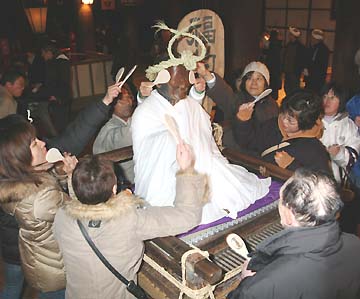
長野市の国宝善光寺本堂で1月6日の夜に行われる「びんずる回し」は、新年恒例の行事。釈迦(しゃか)の弟子で、触った場所の痛みや病気が治るとされる「びんずる尊者」の木像を大勢の参拝者が引き回し、無病息災などを祈ります。
浄土宗一山の住職の読経の後、参拝者が交代で像が置かれた木製の台座から伸びる2本の綱を引っ張り、本堂内を右回りにゆっくりと周回。住職から配られたしゃもじなどでびんずる像に触れ、思い思いに願いを託します。
© 信州歳時記.冬
xxxxxxxxxxxxxxxxxxxxxxxxxxxxx
Bindora Baradaja
賓度羅跋羅惰闍
Also called Binzuru (J). Pindola Bharadraja (Skt).
West; resides with 1,000 disciples in Saikudani-shi (Skt. Aparagodani); the most widely revered of the Arhats in Japan; all the others are less known to Japanese lay worshippers, and they rarely serve as the central objects of devotion.
Pindola, however, according to the Flammarion Iconographic Guide on Buddhism, is the Arhat par excellence in Japan, and is mainly worshipped by lay people.
Quote: "In Japan, Pindola is represented as an old man seated on a high-backed chair, with white hair and bushy eyebrows. Statues of him, in painted wood or stone, are usually well worn, since the faithful follow the custom of rubbing a part of the effigy corresponding to the sick parts of their bodies, as he is reputed to have the gift of healing.
He is also very frequently offered red and white bibs and children's caps to watch over the health of babies, so that his statue is often decked in rags. He is represented in painting as an old man seated on a rock, holding in his hand a sort of sceptre (Japanese shaku), or a sutra box and a feather fan.
All the other Arahants are usually worshipped in Japan in his person. In some cases, his efficgy is placed in monastery refectories, as at the Jikido (Shakudo) in Todai-ji Temple (Nara), and in Hieizan."
Bindora Baradaja 賓度羅跋羅惰闍
by Mark Schumacher
:::::::::::::::::::::::::::::::::::::::::::::::::::::::::::::::::::::::::::::::::::::::::::::::::::::
Binzuru Dance (Binzuru odori) in Nagano
長野びんずる 踊り
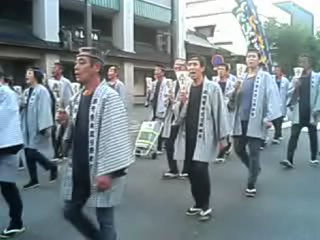
http://wisteria-ts.cocolog-nifty.com/photos/binzuru/binzuru_11.JPG
... ... ...
Dance with Us at the Binzuru Festival!
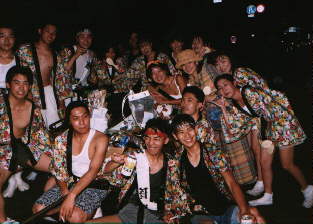
www.osk.3web.ne.jp/logos/shinshu/binzuru.html
Click HERE to see some more of the famous Binzuru statues.
*****************************
Worldwide use
*****************************
Things found on the way
Buddha Statues to rub for good luck
nadebotoke 撫で仏, 撫仏, なでぼとけ
Binzuru, O-Binzuru sama, is the most famous of them all. His statues are in front of many temples.
Statue of Standing Daruma :
You can touch any part of his body which hurts on your own body and pray for good health. Daruma san is especially known for his strong legs, after all he walked quite a way if legend is true...
Usually we have a statue of Binzuru-sama ビンズルさま as a healer to touch. You rub him on the spot where your own body hurts, but here our Daruma takes the part of the healer.
Daruma-ji - A Temple in Nishi Izu
by Gabi Greve
...................
Jizo as a rubbing healer in Asakusa, Tokyo
A healer to touch.
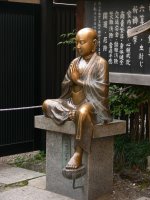
© 白い香り
...................
Fudo Myo-O at Tempel Yokoyamadera横山寺, 島根県隠岐郡隠岐の島町
“痛いところを撫でてお祈りすると治ります”
If you touch the part that hurts you, you will be healed.
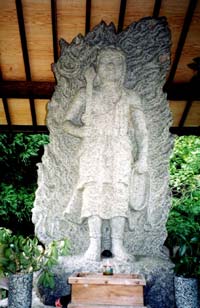
© Nihon no Minwa
Read more about Fudo Myo-O 不動明王 in my BLOG
...................
Here is a badger to be rubbed for good luck, fukutanuki 福狸.
We found him in front of a ricewine store in Kurayoshi, 2006. His breast was quite worn out, he/she must be a helper for mothers with small babies.
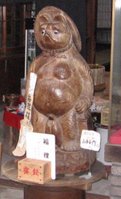
More about the Tanuki and Daruma
狸だるま
...................
Once I visited a small temple way back in the North of Japan. The touching Buddha was a Kannon Bosatsu in a female incarnation, with rather large breasts. She was seated on a lotus throne on a high podest. Mothers would come to her to touch the breast and pray for milk while breastfeeding.
BUT
The statue was so high up, many mothers could not reach the breasts at all. So it was customary in this temple to touch one of her knees instead. And believe me, the knees where all worn out and shiny!
...................
Click HERE to see a few more of these touching healers !
.......................................................................
nadeusagi, nade-usagi なでうさぎ rabbit to rub

大神神社 Omiwa Shrine
- reference : nadeusagi omiwa -
*****************************
HAIKU
Binzuru-mawashi sentoo ayumu to to narinu
I became
the head of the party
for the Binzuru ceremony
((Rikukawa Naonori))
Binzuru is the wooden statue at Zenko-ji temple . The divine grace is to cure illness, and its annual ceremony is held on January sixth. People hit its head by rice spoons with their familiarity to Binzuru to thank for its works for them for a year.
Shiraobi Haiku Magazine, January 2006
http://homepage2.nifty.com/shirawobi/06.01shuukuEnglish.html#label2
:::::::::::::::::::::::::::::::::::::::::::::::::::::::::::::::::::::::::::::::::::::::::::::::::::::
Binzuru in Nara, Temple Todaiji
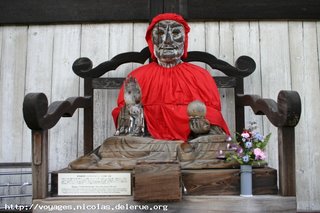
- Photo : Nicolas Delerue -
Issa and his Haiku about Binzuru Sama
びんずるを一なでなでて木の芽哉
binzuru o hito nade-nadete ki no me kana
giving Saint Binzuru
a rub...
the budding tree
Here, a tree's budding branch (ki no me) is doing the lucky rubbing.
びんづるは撫なくさるる紅葉哉
binzuru wa nade nakusaruru momiji kana
keeping Saint Binzuru
from being rubbed...
a red leaf
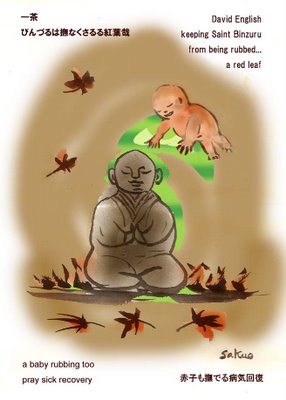
Haiga by Nakamura Sakuo
In this comic haiku, an autumn leaf has fallen onto the statue's holy head.
Sakuo Nakamura notes that Binzuru-sama is famous for his bald head, which people rub in hopes of recovering from sickness. Here, a leaf is doing the rubbing, "like a baby's palm."
びんずるの御膝に寝たる雉哉
binzuru no o-hiza ni netaru kigisu kana
in Saint Binzuru's lap
sound asleep...
a pheasant
びんづるの目ばかり光るけさの雪
binzuru no me bakari hikaru kesa no yuki
Saint Binzuru's
eyes glittering...
this morning's snow
Yoshida Miwako sheds further light on this haiku: in a dark temple, votive lamps darken Binzuru's image with soot, but his glass eyes still glitter. It's a pitiful feeling, Yoshida adds, the glittering eyes in the gloom. On this gray winter day, the first big snow of the year twinkles like Binzuru's eyes. See Issa burai (Nagano: Shinano Mainichi Shimbunsha, 1996) 186.
びんずるの御鼻をなでる小蝶哉
binzuru no o-hana o naderu kochô kana
rubbing St. Binzuru's
holy nose...
little butterfly
In the haiku, a butterfly also strokes the saint for good health.
Tr. David Lanoue
- - - - -
梅さくや手垢に光るなで仏
ume saku ya teaka ni hikaru nade-botoke
plums are blossoming -
the rubbed Buddha shines
from the dirt of hands
Tr. Gabi Greve
. Kobayashi Issa 小林一茶 in Edo .

*****************************
Related words
***** WKD: Ceremonies and Festivals of Japan
. Binzuru sama ema 絵馬 .
Temple Jako-In (Jakoin) at Inuyama 寂光院 犬山
Introducing Japanese Deities
:::::::::::::::::::::::::::::::::::::::::::::::::::::::::::::::::::::::::::::::::::::::::::::::::::::
:::::::::::::::::::::::::::::::::::::::::::::::::::::::::::::::::::::::::::::::::::::::::::::::::::::
Binzuru Sama (Pindola)
Einer von Shakyamunis Jüngern. Der Erste der 16 Arhats, der erste mit übernatürlichen Kräften.
In Japan bald als Gottheit verehrt, die körperliche Leiden und Gebrechen heilt. Daher finden sich seine Statuen oft in den Vorhallen der Tempel, so daß die Gläubigen darum herum laufen können und dabei diejenigen Stellen der Statue berühren, die an ihrem eigenen Körper erkrankt sind. Die Statuen sind entsprechend blank und abgerieben. Besonders bei Holzfiguren sind die Augen und die Nase fast ganz abgerieben.
Oft auch im Refektorium eines Klosters aufgestellt.
Sitzende Figur eines alten Mönchs mit kahlem Kopf, der Oberkörper nackt mit sichtbaren Rippenknochen, mit einem Tuch über den Schultern. Häufig aus Metall gefertigt.
. Buddhastatuen ... Who is Who
Ein Wegweiser zur Ikonografie
von japanischen Buddhastatuen
Gabi Greve, 1994
:::::::::::::::::::::::::::::::::::::::::::::::::::::::::::::::::::::::::::::::::::::::::::::::::::::

Shoohooji 正法寺 Shoho-Ji
Temple 10 of the Bando Pilgrimage
source : facebook
:::::::::::::::::::::::::::::::::::::::::::::::::::::::::::::::::::::::::::::::::::::::::::::::::::::
. komainu 狛犬 / 高麗犬 / 胡麻犬 "Korean Dog" .
nade komainu なでこまいぬ a Komainu to rub

by 加藤藤四郎 Kato Toshiro (Kamakura period)
at the shrine Suehiko Sha 陶彦社
in the compound of 深川神社 Fukagawa Jinja, Aichi

The small figures are sold with the intention to have a wish granted
o-negai Komainu お願い狛犬

- quote -
Fukagawa and Suehiko Shrines
The two adjacent shrines are both extremely old. Fukagawa Shrine is believed to be around 1,200 years old, dating back to the Nara Period of Japanese history, and the shrine's treasure house, has a pair of guardian dogs, komainu, made by the legendary potter Toshiro Kato, the founder of Seto's ceramic industry.
The roof of Fukagawa Shrine
is covered with glazed, green, ceramic tiles called oribeyaki. Look out for the replica statue of a dog in the shrine's grounds near the main hall. Legend has it that during a dream a dog told Toshiro where to dig to find the high quality clay he was searching for. As a sign of thanks Toshiro crafted an image of a guardian dog (komainu) for the shrine. The originals are kept in the treasure house (see below for hours and admission fee).
Suehiko Shrine,
next door, enshrines the spirit of master potter Toshiro Kato, who was active here in Seto in the 13th century.
- source : japanvisitor.blogspot.jp -

Suehiko Jinja 陶彦神社
:::::::::::::::::::::::::::::::::::::::::::::::::::::::::::::::::::::::::::::::::::::::::::::::::::::
[ . BACK to WORLDKIGO TOP . ]
[ . BACK to DARUMA MUSEUM TOP . ]
- #nadebotoke #nadeusagi -
:::::::::::::::::::::::::::::::::::::::::::::::::::::::::::::::::::::::::::::::::::::::::::::::::::::







4 comments:
Thank you Gabi san
for your adding my haiga to your blog referring to Binzuru.
There are many interesting things featured at the blog.
sakuo.
http://groups.yahoo.com/group/happyhaiku/message/3662
Kobayashi Issa
ume saku ya te-aka ni hikaru nade-botoke
plum blossoms --
stroked by dirty hands
the healing Buddha shines
Comment by Chris Drake :
Shikoku Henro
Nr. 19 - 橋池山 Kyochizan 摩尼院 Mani-In 立江寺 Tatsue-Ji
In the compound is a small statue with a very shiny red face. It is a statue of Binzuru, one of the first sixteen disciples of the Buddha. He was a physician and came from a family of distinguished physicians.
.
Baisoin, Baisō-In 梅窓院 Baiso-In - Minami-Aoyama
長青山 Choseizan 寶樹寺 Hoju-Ji
Binzuru 賓頭盧 is venerated near the entrance of the temple.
.
https://gokurakuparadies.blogspot.com/2020/09/baisoin-kannon-minamiaoyama.html
.
Post a Comment